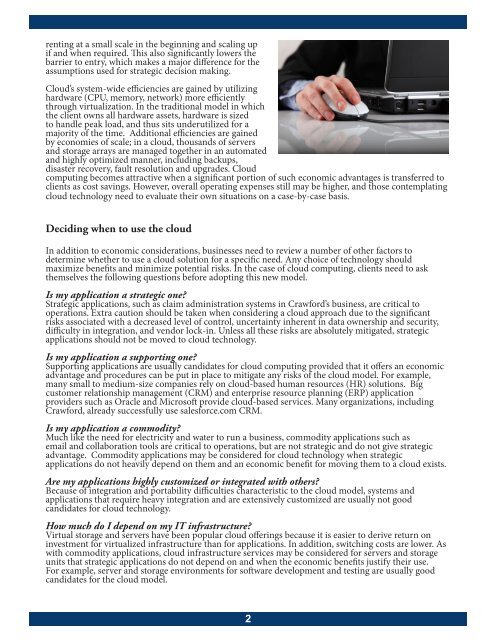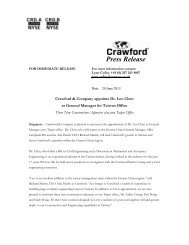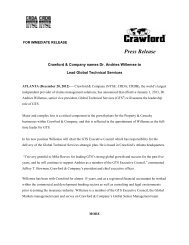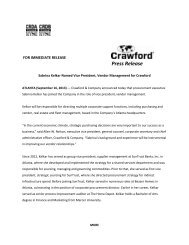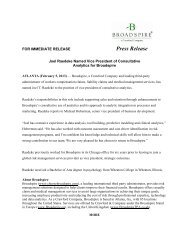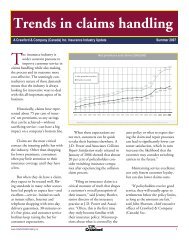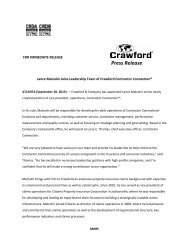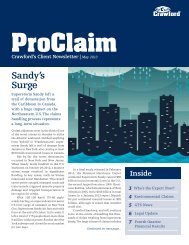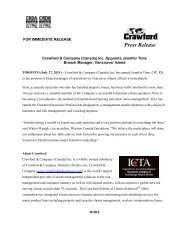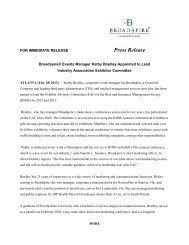The Cloud at Crawford - Broadspire - Crawford & Company
The Cloud at Crawford - Broadspire - Crawford & Company
The Cloud at Crawford - Broadspire - Crawford & Company
You also want an ePaper? Increase the reach of your titles
YUMPU automatically turns print PDFs into web optimized ePapers that Google loves.
enting <strong>at</strong> a small scale in the beginning and scaling upif and when required. This also significantly lowers thebarrier to entry, which makes a major difference for theassumptions used for str<strong>at</strong>egic decision making.<strong>Cloud</strong>’s system-wide efficiencies are gained by utilizinghardware (CPU, memory, network) more efficientlythrough virtualiz<strong>at</strong>ion. In the traditional model in whichthe client owns all hardware assets, hardware is sizedto handle peak load, and thus sits underutilized for amajority of the time. Additional efficiencies are gainedby economies of scale; in a cloud, thousands of serversand storage arrays are managed together in an autom<strong>at</strong>edand highly optimized manner, including backups,disaster recovery, fault resolution and upgrades. <strong>Cloud</strong>computing becomes <strong>at</strong>tractive when a significant portion of such economic advantages is transferred toclients as cost savings. However, overall oper<strong>at</strong>ing expenses still may be higher, and those contempl<strong>at</strong>ingcloud technology need to evalu<strong>at</strong>e their own situ<strong>at</strong>ions on a case-by-case basis.Deciding when to use the cloudIn addition to economic consider<strong>at</strong>ions, businesses need to review a number of other factors todetermine whether to use a cloud solution for a specific need. Any choice of technology shouldmaximize benefits and minimize potential risks. In the case of cloud computing, clients need to askthemselves the following questions before adopting this new model.Is my applic<strong>at</strong>ion a str<strong>at</strong>egic one?Str<strong>at</strong>egic applic<strong>at</strong>ions, such as claim administr<strong>at</strong>ion systems in <strong>Crawford</strong>’s business, are critical tooper<strong>at</strong>ions. Extra caution should be taken when considering a cloud approach due to the significantrisks associ<strong>at</strong>ed with a decreased level of control, uncertainty inherent in d<strong>at</strong>a ownership and security,difficulty in integr<strong>at</strong>ion, and vendor lock-in. Unless all these risks are absolutely mitig<strong>at</strong>ed, str<strong>at</strong>egicapplic<strong>at</strong>ions should not be moved to cloud technology.Is my applic<strong>at</strong>ion a supporting one?Supporting applic<strong>at</strong>ions are usually candid<strong>at</strong>es for cloud computing provided th<strong>at</strong> it offers an economicadvantage and procedures can be put in place to mitig<strong>at</strong>e any risks of the cloud model. For example,many small to medium-size companies rely on cloud-based human resources (HR) solutions. Bigcustomer rel<strong>at</strong>ionship management (CRM) and enterprise resource planning (ERP) applic<strong>at</strong>ionproviders such as Oracle and Microsoft provide cloud-based services. Many organiz<strong>at</strong>ions, including<strong>Crawford</strong>, already successfully use salesforce.com CRM.Is my applic<strong>at</strong>ion a commodity?Much like the need for electricity and w<strong>at</strong>er to run a business, commodity applic<strong>at</strong>ions such asemail and collabor<strong>at</strong>ion tools are critical to oper<strong>at</strong>ions, but are not str<strong>at</strong>egic and do not give str<strong>at</strong>egicadvantage. Commodity applic<strong>at</strong>ions may be considered for cloud technology when str<strong>at</strong>egicapplic<strong>at</strong>ions do not heavily depend on them and an economic benefit for moving them to a cloud exists.Are my applic<strong>at</strong>ions highly customized or integr<strong>at</strong>ed with others?Because of integr<strong>at</strong>ion and portability difficulties characteristic to the cloud model, systems andapplic<strong>at</strong>ions th<strong>at</strong> require heavy integr<strong>at</strong>ion and are extensively customized are usually not goodcandid<strong>at</strong>es for cloud technology.How much do I depend on my IT infrastructure?Virtual storage and servers have been popular cloud offerings because it is easier to derive return oninvestment for virtualized infrastructure than for applic<strong>at</strong>ions. In addition, switching costs are lower. Aswith commodity applic<strong>at</strong>ions, cloud infrastructure services may be considered for servers and storageunits th<strong>at</strong> str<strong>at</strong>egic applic<strong>at</strong>ions do not depend on and when the economic benefits justify their use.For example, server and storage environments for software development and testing are usually goodcandid<strong>at</strong>es for the cloud model.2


